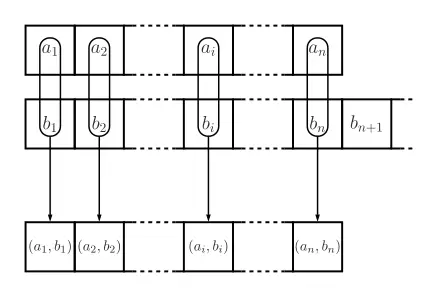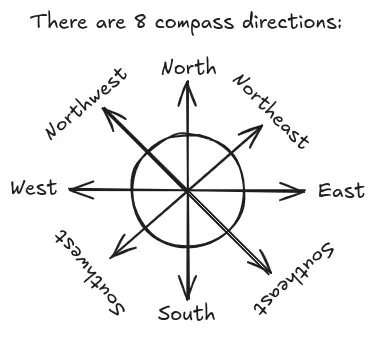Advent of Code 2024: Summary of Days 1 to 6
06 Dec 2024This page serves as the first part of a summary of my experience with Advent of Code 2024. A mentioned in my original post, I decided against forcing myself to learn another programming language as well as opted not to post an article for each challenge.
As per the FAQ, I won’t be including the puzzle text or raw inputs in this post. Please use the links to the questions for context. I’ve opted to call the 2 parts to each question Part A and Part B, these are normally just called Part One and Part Two in the questions, but I think A and B differentiate them more clearly.
The notes within this article could potentially be helpful for those getting stuck on questions, if used as hints. I will eventually publish my solutions as a repository.
This post covers the first 6 days of Advent of Code 2024. For days 7 to 12 see the next post.
Day 1
Day 1 introduced relatively straightforward challenges focussing on sorting lists and comparing values.
I opted to insert the data presented into the 2 lists in order, rather than loading them and calling a sort function. This meant iterating over the lists for each entry.
Part A was done by simply zipping the two collections together and comparing the values. The diagram below shows how this works based on the Scala Visual Reference:

Part B was done with some nested loops. Additionally, I cached the scores for each unique number to avoid needless extra loops.
Day 2
Day 2 was a similar level of difficulty to Day 1.
Part A was very simple, checking if ascending or descending was simple, and the difference was likewise trivial.
Part B is a little more involved, but I ended up opting to run the same algorithm as Part A on multiple versions of the input that omit single entries, making it relatively simple.
It is likely possible to do Part B in a single loop rather than by running the solution to Part A multiple times, but in the interest of speed and readability I opted not to do this.
Day 3
Day 3 gets a little harder than the first 2 days.
These puzzles have you implement a rudimentary parser/interpreter.
Part A was simple enough and can be done with a simple Regular
Expression like
mul\((\d{1,3}),(\d{1,3})\) or by writing a manual string parser.
Part B is a little more difficult as it involves conditional turning on and off
of the previous command. In theory, if you wrote a manual parser, you could do
this on the fly as you parse the instructions. I however opted for an easier,
less efficient approach. I wrote 2 more regular expressions to detect the do
and don't instructions, and ran all 3 expressions on the input, collected the
output, and sorted them by location. Then I just iterated over the instructions
one at a time, keeping track of the enabled state.
Day 4
Day 4 was probably on par in difficulty with Day 3.
The first part was a nice simple wordsearch. I built a data structure containing all the characters in it, essentially a 2 dimensional array. From there I looked through each character in all the compass directions for the search string.

Thanks to the way I structured my code in the first part, the second part wasn’t too hard to achieve as the search code I wrote could be applied to the 4 different X configurations.

Day 5
Day 5 was the first puzzle whose input is divided into 2 parts that need parsing. This was very easy since the data is well formatted and divided by a blank line.
Part A involved filtering the list of rules presented as the first part of the
input to those valid for each list of integers in the second part of the input.
After which you had to verify if the list matched those rules. This is
relatively simple as the rules are formatted as number1|number2 which means
that number1 must come before number2 in the list, which can be checked
with simple nested loops that exit early upon failure.
Part B required you to take the lists that were invalid, and sort them based on the rules that applied to that list. This was a little more involved, but I settled on a simple sorting algorithm that did the following:
- Starting at the back of the list, set the current index to be the last index in the list
- Find the earliest index the current number can be in the list based on the rules
- Shift the current number to the earliest index if it needs to move, otherwise move backward in the list and set the current index to 1 less
- Repeat steps 2 and 3 until the current index reaches -1
This looks something like this animated GIF for the last example given with the question:

A step-by-step, stationary version of this GIF can be seen here.
Part A could have been solved by implementing the sorting algorithm for Part B and comparing the 2 outputs. If you did it this way, well done!
Day 6
Day 6 came out on a Friday and capped off the first full working week of December 2024 and will serve as my stopping point in this post.
Day 6 marked a difficulty spike with a simple pathfinding puzzle. Part A was straightforward: you needed to track your guard’s movements around the map and count the amount of unique locations they visited.
Having done Advent of Code previously, I recalled that some of these path finding grid puzzles involve loops. Detecting loops is important because they can lead to infinite traversal, which will cause your algorithm to run continuously if not dealt with.
To account for loops and infinite traversal, I added loop detection to my Part A solution, I did this by keeping track of the walls that the guard collided with and from what direction. This works because the rule of turning 90 degrees upon collision means that if you encounter the same wall from the same direction you must be stuck in a loop.
Part B of Day 6 required putting the guard in a loop by placing a single obstacle on the map. This meant my loop detection code was readily applicable. My approach to this challenge was brute force: I placed a wall at every unique visited location before rerunning the path finding from the start. While this is a slow approach, it effectively solves the problem.

I’m certain there are faster solutions to Part B, such as projecting collision paths instead of testing every possibility, and I plant to revisit this challenge to explore these optimisations.

Overall
Overall, the first quarter of Advent of Code wasn’t too difficult and offered a nice set of brainteasers. I’d recommend them to people of all skill levels. They test you on your fundamentals and are great programming practice that can sharpen both your problem-solving and comprehension skills
I am already enjoying the steady increase of difficulty and variety of the problems. Day 5 Part B was especially fun, and I was quite proud of my solution. While Python’s well-documented sorting techniques could have made it more concise, manually coding my sorting routine was a great reminder of good algorithm design practices.
If you’re tackling the challenges yourself, I’d love to hear about your experience, your solutions, what you found difficult and any other impressions you have. So feel free to comment under this post wherever I share it.
Further Days
I will release an additional post for the next 6 days. My goal is to release these a while after the last day mentioned on them in an effort to avoid spoiling the challenge for others.
For days 7 to 12 see the next post.


Comments